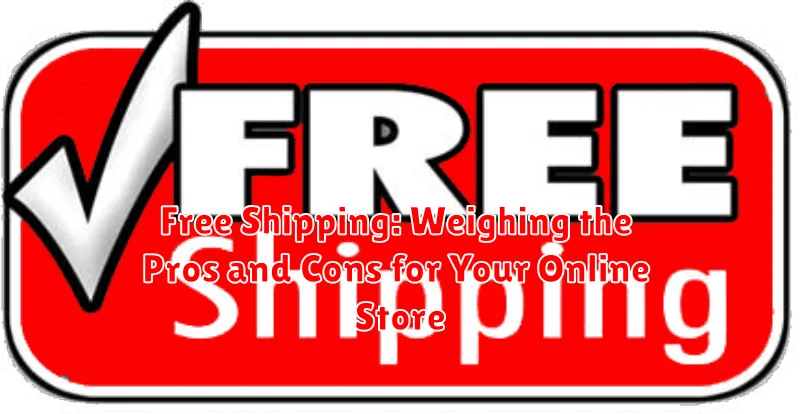Offering free shipping is a popular tactic for online stores, often touted as a surefire way to boost sales and attract customers. But is it always the best strategy for your business? This article delves into the complexities of free shipping, exploring the advantages and disadvantages to help you determine if it’s the right choice for your online store. We’ll weigh the pros and cons of free shipping, considering factors like profit margins, average order value, and customer expectations, to provide you with the information you need to make an informed decision.
While the allure of free shipping is undeniable, the costs involved can significantly impact your bottom line. Understanding the potential impact on your profitability is crucial. This article will examine various free shipping strategies, such as offering it conditionally based on order value or membership programs, and analyze how these options can affect your overall profitability. By carefully considering the pros and cons, you can develop a free shipping strategy that aligns with your business goals and enhances your customer’s shopping experience without compromising your financial stability.
Understanding the Allure of Free Shipping
In today’s competitive e-commerce landscape, free shipping has become a powerful incentive for online shoppers. The allure is simple: customers appreciate the transparency and predictability of a final price that doesn’t change at checkout. The added expense of shipping can often deter a purchase, especially for lower-priced items, making the “free shipping” label a major psychological trigger for completing a sale.
Free shipping offers a sense of value and convenience. Shoppers perceive it as a bonus, a perk that enhances their overall shopping experience. This perception can be particularly influential for price-sensitive customers or those comparing similar products across different platforms.
Furthermore, the prominence of large marketplaces offering free or discounted shipping programs has normalized this expectation among consumers. Many shoppers now actively seek out free shipping options, making it a key differentiator for businesses looking to stand out in a crowded online marketplace.
The Benefits of Offering Free Shipping: Increased Sales and Customer Loyalty
Free shipping can be a powerful incentive for online shoppers. It often influences purchase decisions, encouraging customers to complete their orders rather than abandoning their carts due to added shipping costs. This can lead to a significant increase in sales, especially during promotional periods or for impulse buys.
Beyond immediate sales boosts, free shipping fosters customer loyalty. Customers perceive free shipping as a valuable perk and are more likely to return to an online store that offers it. This repeat business contributes to long-term revenue growth and strengthens the customer-business relationship. The perceived value often outweighs a slightly higher product price, making customers feel they are getting a better deal overall.
Offering free shipping can also give you a competitive edge, especially in crowded markets. It can be a key differentiator that sets your store apart and attracts price-sensitive customers. This is particularly important in industries where free shipping is becoming a standard practice.
The Potential Downsides of Free Shipping: Reduced Profit Margins and Complex Logistics
While free shipping is a powerful incentive, it’s crucial to acknowledge the potential drawbacks. A primary concern is the impact on profit margins. Absorbing shipping costs can significantly reduce profitability, especially for businesses with lower average order values or bulky, heavy products.
Reduced profit margins can necessitate raising product prices, which can impact competitiveness. Alternatively, businesses may have to accept lower profits, potentially hindering growth and reinvestment.
Complex logistics present another challenge. Offering free shipping often requires streamlined order fulfillment and inventory management. Meeting increased demand while managing shipping costs efficiently can strain resources and require investment in new systems or partnerships.
Increased handling costs are also a factor. Free shipping can lead to higher return rates, as customers might be more inclined to order multiple sizes or variations knowing they won’t incur return shipping fees. Processing these returns adds to operational expenses.
Calculating the True Cost of Free Shipping for Your Business
Before implementing free shipping, it’s crucial to calculate the actual cost to your business. This goes beyond simply the carrier’s shipping fee.
Direct Costs: These are the most obvious expenses and include the shipping fees charged by carriers, as well as packaging materials like boxes, tape, and padding.
Indirect Costs: These are less obvious but equally important. Consider the labor costs associated with packaging and shipping orders. Also, factor in the cost of handling returns, which tend to increase with free shipping offers.
Absorbed Costs: Offering free shipping often means absorbing some or all of the shipping costs into your product pricing. Accurately calculating this requires analyzing your average shipping cost per order and adjusting your product prices accordingly.
A simple way to calculate the true cost is to add up all direct and indirect costs over a period (e.g., a month), divide this by the number of orders shipped, and then add the absorbed cost portion based on your pricing strategy. This provides a comprehensive cost per order shipped with free shipping.
Strategies for Implementing Free Shipping Effectively
Implementing free shipping strategically is crucial for maximizing its benefits while minimizing potential drawbacks. Several approaches can help achieve this balance.
Conditional Free Shipping
Offering free shipping above a minimum order value encourages larger purchases. Setting the threshold strategically, based on average order value, can significantly increase sales. This tactic offsets shipping costs through increased cart totals.
Free Shipping on Specific Items
Promote specific products or clear out excess inventory by offering free shipping only on those items. This targeted approach can boost sales for chosen products without impacting overall profit margins as significantly.
Membership Programs
Reward loyal customers with free shipping through a paid membership program. Members benefit from consistent free shipping, encouraging repeat business, while the membership fee offsets the shipping costs. This cultivates a strong customer base and generates predictable revenue.
Limited-Time Promotions
Creating a sense of urgency with limited-time free shipping promotions can drive sales during specific periods. This tactic can be effective during holidays or special sales events, generating short bursts of increased revenue.
Alternatives to Free Shipping: Flat-Rate or Conditional Free Shipping
If offering free shipping across the board isn’t feasible for your business, consider these alternatives:
Flat-Rate Shipping
With flat-rate shipping, you charge a fixed shipping fee regardless of the order’s weight or destination. This simplifies calculations for both you and your customers, offering predictability. However, it might not be equitable for all orders. Small, lightweight orders could be overcharged, while large, heavy orders could be undercharged.
Conditional Free Shipping
Conditional free shipping offers free shipping only when certain criteria are met. This could be a minimum order value, specific product purchases, or membership in a loyalty program. This approach incentivizes larger purchases and can boost customer loyalty while mitigating the costs associated with free shipping on every order.
Choosing between flat-rate and conditional free shipping hinges on your product margins, average order value, and target audience. Carefully consider these factors to determine the most suitable approach for your business.
Free Shipping vs. Discounted Shipping: Which is Right for You?
Both free and discounted shipping can attract customers, but they impact your profit margins differently. Choosing the right strategy depends on your business model and target audience.
Free shipping absorbs the entire shipping cost, making it appealing to customers. However, you must factor this cost into your product pricing, potentially raising prices overall. This works well if your average order value is high enough to offset shipping expenses or if you can negotiate bulk discounts with carriers.
Discounted shipping offers a reduction in the shipping cost, sharing the burden between you and the customer. This can be a good compromise, still offering an incentive without completely eliminating your shipping revenue. Consider offering tiered discounts, like a higher percentage off for larger orders, to encourage increased spending.
Choosing between free and discounted shipping requires careful cost analysis. Evaluate your average order value, product margins, and shipping expenses to determine which approach maximizes profitability while remaining competitive.
Making the Right Decision for Your E-Commerce Store: A Balanced Approach
Ultimately, the “right” decision regarding free shipping depends on a thorough understanding of your business, target audience, and competitive landscape. There is no one-size-fits-all solution. A balanced approach involves carefully weighing the potential benefits against the undeniable costs.
Consider conducting A/B testing to determine the impact of different shipping strategies on your conversion rates and average order value. Analyze your product margins, shipping expenses, and customer demographics to identify the most sustainable and profitable approach.
Flexibility is key. Your optimal strategy might involve a combination of approaches. For example, you could offer free shipping on orders above a certain threshold, while charging a flat rate for smaller orders. Continuously evaluate and adjust your strategy based on performance data and market trends.
By taking a balanced, data-driven approach, you can leverage shipping strategies to enhance customer satisfaction and drive business growth without jeopardizing profitability. Focusing on the customer experience, while maintaining a sustainable business model, is crucial for long-term success.
Analyzing the Impact of Free Shipping on Your Bottom Line

Free shipping can significantly impact your profitability. A thorough analysis is crucial before implementation. Consider these key factors:
Increased Order Value: Free shipping often encourages larger orders as customers aim to maximize the perceived benefit. Track your average order value (AOV) before and after implementing free shipping to measure its impact.
Shipping Costs: Factor in the average cost of shipping per order. This will depend on your product’s weight, dimensions, and shipping destination. Negotiate rates with carriers to minimize expenses.
Product Margins: Evaluate your product margins to determine if they can absorb shipping costs. You might need to adjust pricing or source lower-cost products.
Competitor Analysis: Research your competitors’ shipping policies. Understanding their strategies can help you make informed decisions and stay competitive.
Profitability Calculation: Calculate the overall impact on profitability by considering the increase in sales, the cost of shipping, and any necessary price adjustments.
Examples of Successful Free Shipping Strategies

Several businesses have effectively implemented free shipping to boost sales and customer satisfaction. Here are a few examples demonstrating different approaches:
Threshold-Based Free Shipping
Threshold-based free shipping, a common tactic, offers free shipping once a customer’s order total reaches a specific amount. For example, a clothing retailer might offer free shipping on orders over $75. This encourages customers to add more items to their cart to reach the free shipping threshold, increasing the average order value.
Product-Specific Free Shipping
Some businesses offer product-specific free shipping to promote certain items or clear out excess inventory. For instance, a furniture store might offer free shipping on select sofas to drive sales in that category. This targeted approach can be highly effective for moving specific merchandise.
Membership-Based Free Shipping
Membership programs that include free shipping as a perk can cultivate customer loyalty. Amazon Prime is a prime example of this strategy. Customers pay an annual fee for benefits, including free and expedited shipping, which encourages them to prioritize purchasing from that platform.
Limited-Time Free Shipping Promotions
Offering limited-time free shipping promotions, like during holidays or special sales events, creates a sense of urgency and encourages immediate purchases. This can be a powerful tool for boosting sales during specific periods.

